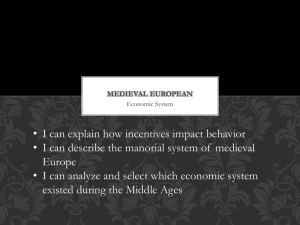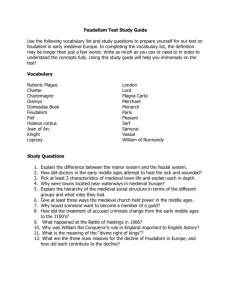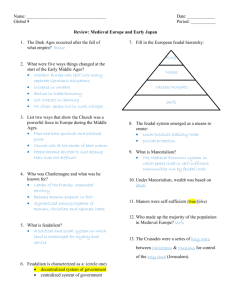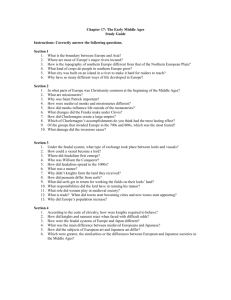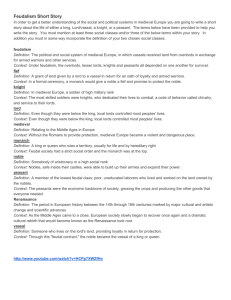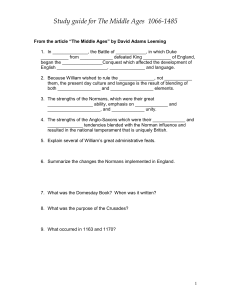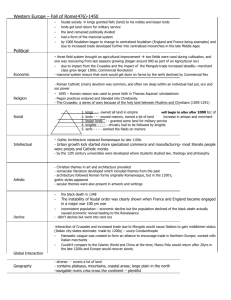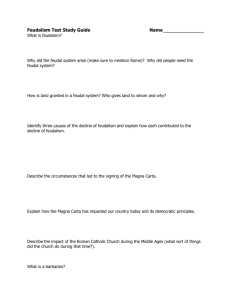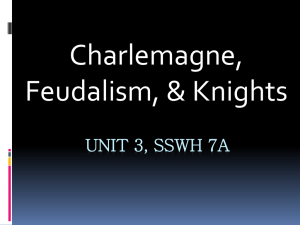Feudalism & the Manorial System
advertisement
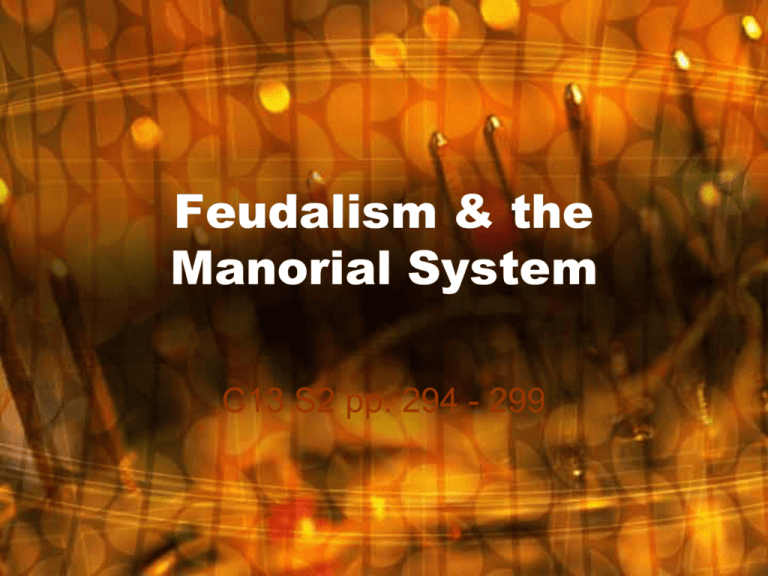
Feudalism & the Manorial System C13 S2 pp. 294 - 299 Objectives • Explore how feudalism helped shape political & social development in Europe during the Middle Ages • Identify the ways in which the manorial system influenced economic growth in Europe during the Middle Ages Feudalism • The system – Lords- powerful nobles who granted land (fief) to lesser nobles in return for loyalty & military assistance – Vassals- did not own land; could further divide his land (knights) – Primogeniture – fief became hereditary, passed from vassal to eldest son Feudalism (cont) • Warfare – private fights between feudal lords – Nobles- potential wealth & glory – Most people- wars caused great suffering & hardship Feudalism (cont) • Feudal justice – Trial by battle- duel between accuser & accused – Oath taking- people swore the accuser/accused was telling the truth • Character witness – Trial by ordeal- accused underwent “ordeals” such as plunging hand in boiling water, immersion in cold water, carrying a piece of hot iron, etc • If wounds healed quickly, person was innocent Manorial System • Manors were large, self-sufficient farming estates shared by lords & peasants – Included manor houses, cultivated lands, woodlands, pastures, fields, & villages The Manorial System • Peasant life – serfs led very difficult lives – Lords kept 1/3 of the land for himself, peasants farmed remaining 2/3s • Gave crops, helped farm, & paid taxes – Could not leave land without lord’s permission The Manorial System (cont) • Nobles’ lifestyles – castle was the fortified base – Not luxurious; chilly rooms with thick walls & small windows with no glass The Manorial System (cont) • Chivalry – rules that dictated knights’ behavior – Page > Squire > Knight – Expected to be courageous, fair, loyal, honest, gallant, & courteous to women Travel Agents • Imagine that they work for a time travel agency. You need to develop a brochure explaining feudalism and the manorial system to travelers who wish to visit medieval Europe. • Brochures should include the following: – definitions of terms, such as vassal, fief, and lord – information about feudal justice and warfare – a brief note about chivalry • Include illustrations and graphic organizers to help clarify the system of feudalism • A graphic representation of the feudal hierarchy would be particularly helpful. • The purpose of your brochure is to prepare travelers to exist within the political system they Your Coat of Arms • Your coat of arms should symbolize you as person – Consider past events, people, places, or animals that are significant to you – Also you should consider symbols that will represent qualities/characteristics from the code of chivalry you possess Colors • • • • • • • • • Gold- Generosity and elevation of the mind Silver or White- Peace and sincerity Red- Warrior or martyr; Military strength Blue- Truth and loyalty Green- Hope, joy, and loyalty in love Black- Constancy or grief Purple- Royal majesty, sovereignty, and justice Orange- Worthy ambition Maroon- Patient in battle, and yet victorious THE CHURCH C13, S3 pp. 300-303 Objectives • Describe how the church hierarchy fit into society • Explain how the practices of monasticism changed • Explore how the church influenced life in medieval Europe The Church Hierarchy The medieval church had widespread political power I. The church had a highly structured hierarchy a) b) c) d) e) Parish priests were lowest in rank, but could administer sacraments Bishops managed a group of parishes called a diocese Archbishops had authority over all the bishops of the archdiocese Cardinals (Curia) advised pope on legal and spiritual matters Pope held supreme authority in the church Monasticism II. Monks a) b) c) d) and nuns believed that they had to withdraw from the world and its temptations to live a Christian life Monks and nuns lived in isolated communities They chose to serve God through fasting, prayer, and self-denial. Spent most of their days in prayer The Benedictine Rule – rules to govern monk’s lives The Church & Medieval Life III. Church rules and laws affected both the clergy and the parish a) The church had its own code of law, called canon law, and its own courts b) Church punishment might be excommunication, which is being thrown out of the church c) The church could issue an interdict against an entire region, which would close the region’s churches and prohibit the performance of marriages, burials, and other sacraments there. d) Parishioners paid tithes, or 1/10th of their income to the church. The Church & Medieval Life (Cont) Political role – pope was political & religious leader Economic & social role – some monasteries were involved in trade e) f) IV. Problems of the church: a) b) Lay investiture- practice of noble, such as a king appointing a friend or relative to be a bishop or abbot Simony- practice of buying high church positions V. Effects of the Church a) Positive b) Negative Provided leadership that the governments of the time could not The church’s great wealth and influence led to internal corruption
